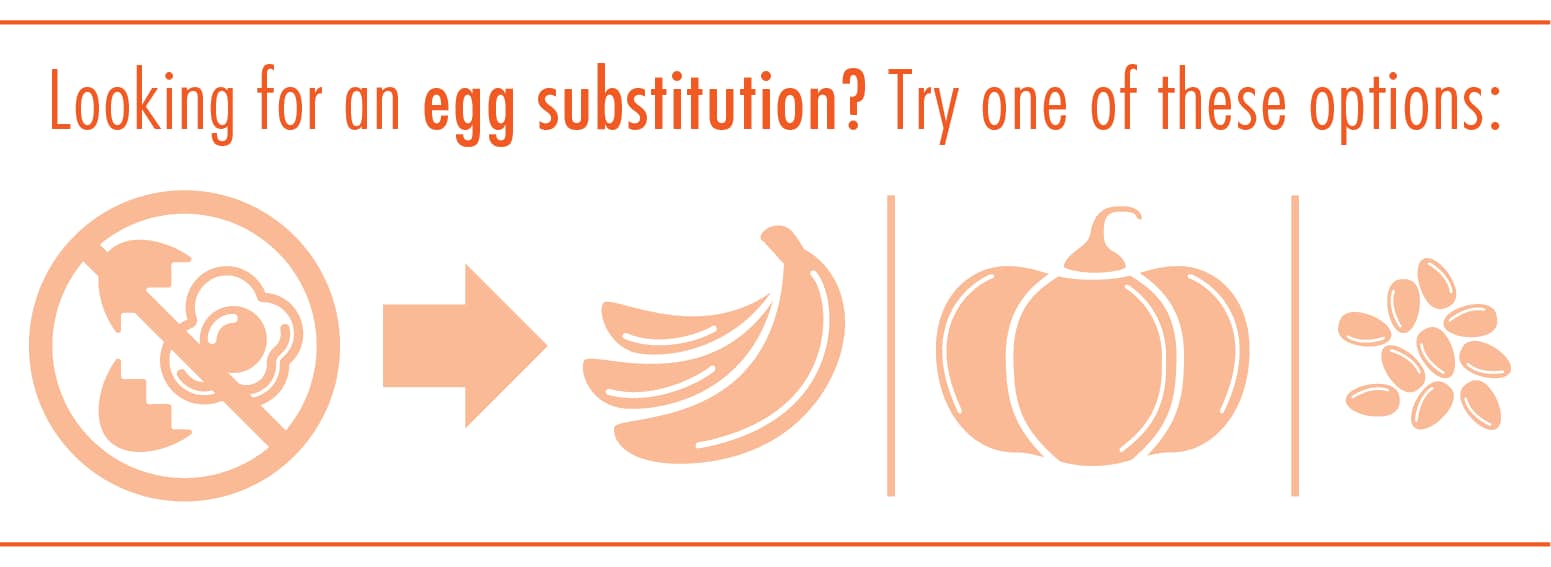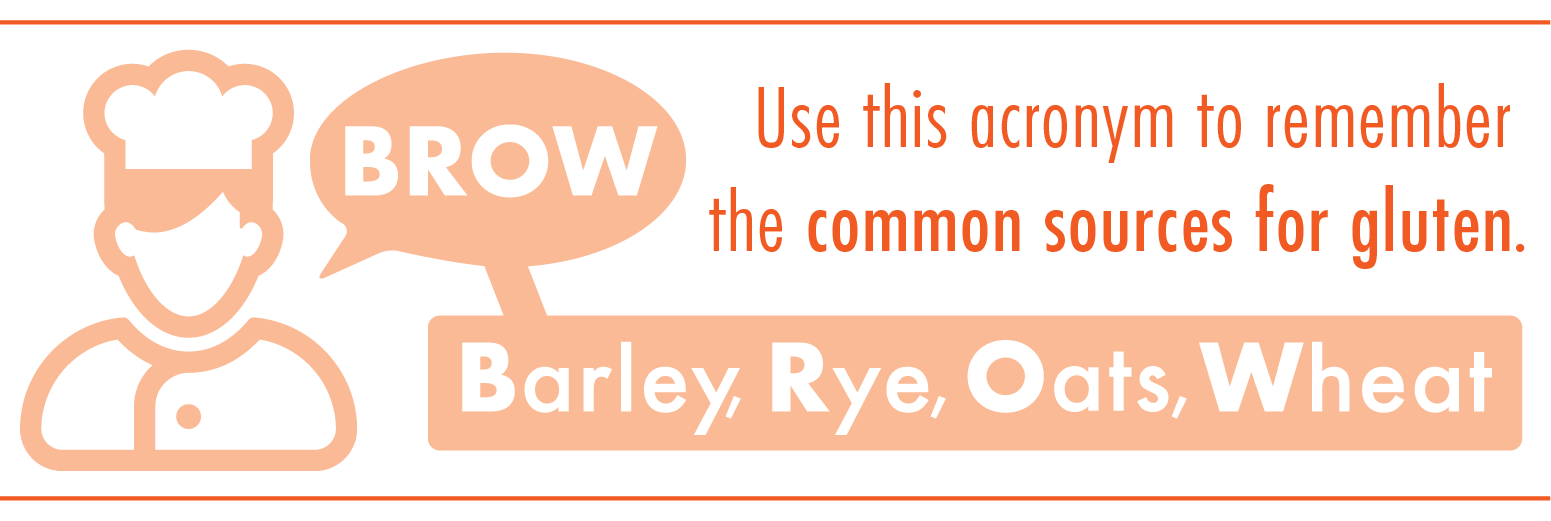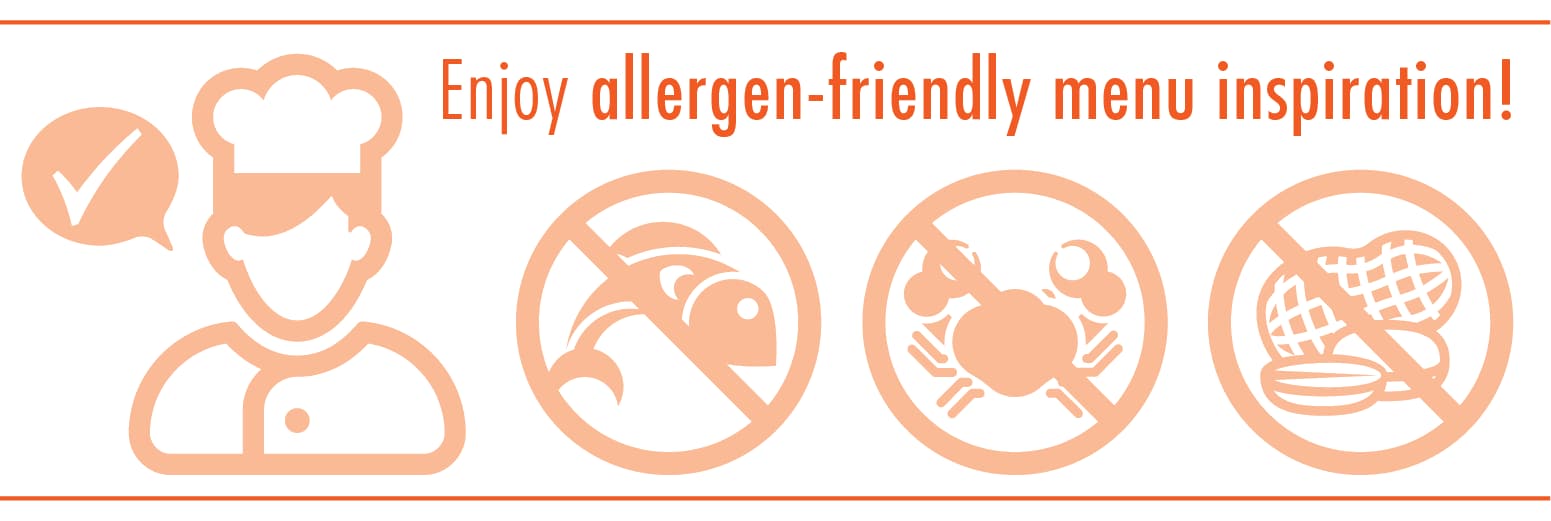Having allergen friendly recipes on hand can help you drive new traffic and increase loyalty from your customers with food allergies. Simple substitutions can help you appeal to those diners as well as bring new dimensions to traditional recipes.
Substitution Recommendations

Eggs
To replace eggs for binding in sweet applications, try using bananas or applesauce. For savory recipes, use pumpkin or squash puree.
Flaxseed offers another solution to substituting eggs, combine 1 tablespoon ground flaxseed with 3 tablespoons of water and let sit for 5 minutes. Use this 1:3 ratio for each egg being replaced. To ensure your recipes will still rise, make sure there’s still enough baking soda and baking powder.
Milk
Almond, hemp, rice, coconut, and soy milk are all great replacements for their dairy counterparts. Beyond their obvious taste differences, be cautious of browning and texture when they’re used in hot applications. The wide range of sugar levels can make some of these substitutes unsuitable for specific recipes, so opt for unsweetened and unflavored varieties.
Chef Jill Recommendations:
- Make a lasagna that relies on cashew or almond ricotta instead of traditional ricotta cheese.
- Substitute sparkling water for milk in your favorite waffle recipe to make a dairy-free chicken and waffles.
Fish
Although avoiding fish can seem simple, there are a variety of cuisines that use sauces and marinades made with this common allergen. For instance, many Worcestershire sauces list anchovies as an ingredient. In many east Asian cuisines, fish sauce is a major component that adds saltiness and depth to a recipe. There are actually many vegan “fish” sauces on the market that are suitable for these applications. Or, you can make your own with wakame, garlic, peppercorns, soy sauce, and miso.
Chef Jill Recommendation:
- Make a rich pho broth with extra soy sauce, instead of fish sauce.
- The lemongrass, cloves, and star anise will mask the missing fish sauce.
Crustaceans
Given there can be a wide variety of hidden shellfish sources (gelatin, salad dressings, sauces, fish stock) it is imperative to double check labels and “may contain” claims. To create dishes that traditionally contain shellfish, creativity and seasoning are key. Try using fish and vegetables that can mimic the texture of some popular dishes such as hearts of palm for crab, mushroom sauce to replace oyster sauce, or tofu for scallops.
Peanuts and Tree Nuts
Peanuts, and tree nuts are becoming less common in food service kitchens due to the increase in severe allergy sufferers, but that doesn’t make the need to remain vigilant with this allergen any less important,
To recreate the texture and flavor of peanuts or tree nuts in a recipe, or as a garnish, use seeds, oven-roasted beans, or even crumbled pretzels.
Chef Jill Recommendation:
- Experiment with seeds as a substitute for nuts. Seeds often have a nutty flavor and crisp texture that mimics nuts. Although people can be allergic to sunflower seeds or flaxseeds, these cases are generally very rare.
- Simply omit the nuts when making pesto, or try pumpkin seeds instead. Or toast sunflower seeds and use them in place of peanuts in Kung Pao.

Wheat and Gluten
Although a wheat allergy should not be confused with celiac disease or gluten intolerance, many of the same foods are avoided. However, it is important to distinguish that not all wheat-free foods are also gluten-free (for example, barley and rye are wheat-free, but do contain gluten). Gluten-free foods are generally safe for those allergic to wheat which is why it is always important to talk to guests and check labels.
Every chef who is concerned with gluten needs to know the most common sources. Teach your staff about “B.R.O.W.” (barley, rye, oats, and wheat) for an easy way to remember those ingredients.
The hidden sources of gluten and wheat can be the most concerning, e.g., Worcestershire, soy sauce, salad dressings, sauces, gravies, thickeners, candy/gum, or chocolate. But there are delicious wheat-free and gluten-free substitutes and even applications that are better than the originals.
When using gluten-free flour blends, avoid those that are mostly made of white rice flour and refined starches. Using a blend that includes at least some brown rice, teff, quinoa, or sorghum flours will add depth and structure your recipes. With a trusted gluten-free blend, a chef can make delicious sauces, breads, pastries, and pastas.
Note: individuals who are diagnosed with celiac disease will often also suffer from lactose intolerances, so being able to make a recipe gluten and lactose free is ideal.
Tip from our Registered Dietitian:
- Although oats are commonly contaminated with gluten, oats do not naturally contain gluten and are often tolerated by those with celiac disease, provided the oats are certified as gluten-free. Be sure to look for the gluten-free certification when sourcing oats as a simple solution.
- Consider making a flatbread with a cornmeal crust or start your next roux for gumbo using rice flour.
Soybeans
Soy allergies are very common and the allergen can be easy to identify (Soya, soy protein, soy sauce, edamame, tamari, tempeh, tofu, and TVP). Other times they are less easy to find (miso, shoyu, vegetable gum, vegetable stock, salad dressing).
When necessary you can replace edamame with beans, peas, and other legumes. Seitan is a good alternative for tofu and is showing up more often in trend reports. For soy sauce or tamari, use coconut aminos, a sweet-salty sauce that looks and tastes like soy sauce but is made from fermented coconuts sap.
Chef Jill Recommendations:
- Make a green papaya salad with coconut amino dressing.
- Organic and biodynamic wines are often lower in sulphites or without added sulphites. However, keep in mind that wine is a natural source of sulphites and may not be tolerated by some individuals.

Allergen-Friendly Menu Inspiration from Chef Kyla
Consider these dishes to accommodate some of the more common allergies—or simply as fresh spins on standard recipes.
For Fish Allergies: Hawaiian “Poke” with Soy Marinated Diced Tomato Flesh
The tomato does a good job of recreating the texture of the fish in traditional poke bowls while the other ingredients you choose round out the rest of the experience.
For Crustacean Allergies: Crab Cakes with Hearts of Palm
Shredded hearts of palm can be bound and fried to duplicate the savory goodness of crab cakes.
For Peanut Allergies: Massaman Chicken Curry with Cashews
Make sure your guest isn’t allergic to cashews as well, but simply swapping peanuts for cashews makes a delicious alternative. When preparing this dish, instruct your back-of-house staff to be super cautious to not use utensils that may have touched peanuts.